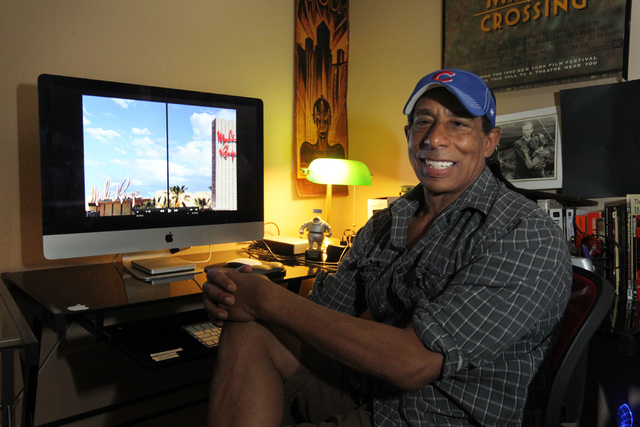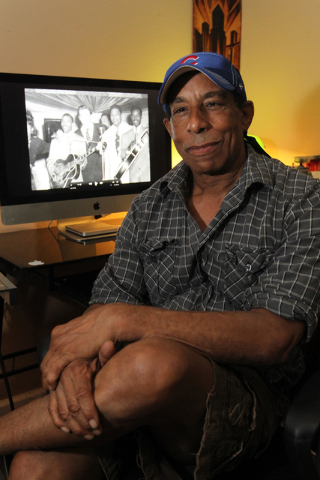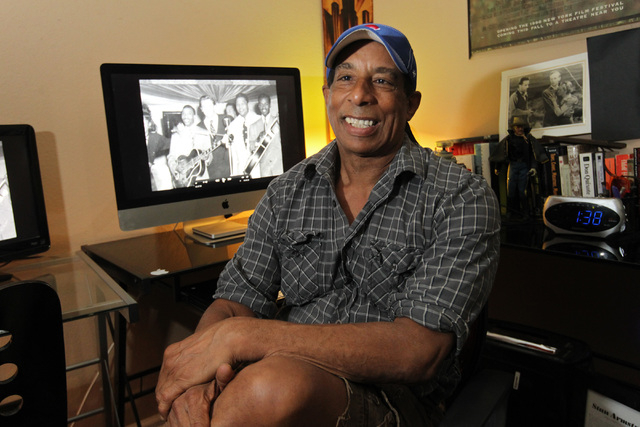Filmmaker explores ‘misunderstood’ Moulin Rouge
It was 60 years ago when the Moulin Rouge, the city’s first racially integrated hotel, opened in historical west Las Vegas offering the African-American community access to what Strip hotels denied.
Although the establishment had famous patrons such as Sammy Davis Jr., Louis Armstrong and Lena Horne, it attracted local families, too, filmmaker Stan Armstrong says.
“(My dad) took my mom, her cousin and other family members to the show at the Moulin Rouge,” he says.
Armstrong has spent the past five years working on the history of the Moulin Rouge. He plans to debut his film “The Misunderstood Legend of the Las Vegas Moulin Rouge” at 2 p.m. May 24 at the West Las Vegas Library, 951 W. Lake Mead Blvd. Admission is free.
Both Armstrong’s parents grew up in Louisiana, although they didn’t meet until they were in San Francisco. Looking for opportunity, the family came to Las Vegas in 1955 when Armstrong was a year old, raising him in west Las Vegas.
It was during the time when the Moulin Rouge opened for business as the first Las Vegas hotel that allowed black patrons. Historians say when Frank Sinatra and Davis would finish with their shows they would head to the Moulin Rouge — primarily because despite being a performer, Davis wasn’t allowed to socialize in Strip hotels because he was black.
Armstrong’s parents were patrons of the property, which survived a mere six months.
“People always ask me why the Moulin Rouge only lasted six months,” Armstrong says. “There are a lot of theories and rumors.”
Even after it closed, the Moulin Rouge played a role in desegregation efforts in Las Vegas. After the threat of protests on the Strip in the 1960s, community leaders and political officials met at the property to officiate what is known as the Moulin Rouge Agreement, in which all hotels agreed to become integrated.
During this time, Armstrong’s parents worked for other casinos — his father was a porter at the Dunes and his mother worked as a powder room attendant at the Mint.
Although his dad had only a fourth-grade education, he imparted a thirst for knowledge in Armstrong that shaped his life.
“I remember I had to read ‘Up From Slavery,’ ” he says. “If I didn’t have portions of it read by the time my dad got home, I couldn’t go outside and play.”
His parents were purposeful in telling Armstrong and his siblings about the events happening across the country and even took time to explain television shows that they watched.
“Television back then had a lot more substance,” he says.
Although his parents instilled a thirst for knowledge, it was movies and television that started to shape a calling for him.
Sitting with his brother watching “Bonnie and Clyde,” Armstrong, who was 14 at the time, started to consider life as a filmmaker.
Armstrong eventually made his way to UNLV in the ’90s to study film and communications with a minor in history.
During an ethnic studies course, his teacher spoke about the Civil War, discussing topics such as black soldiers and the Fort Pillow Massacre, which is where 300 African-American soldiers were killed.
“I made a promise that one day, I would make a film about it,” Armstrong says.
The class inspired him to learn more about the Civil War, and he began watching the documentary by Ken Burns.
“These people had been dead for more than 100 years, but he was able to bring their stories to life through these images,” he says. “History is important to who we are.”
In 1995, after he finished his degree, his brother died of an illness. The time of sadness was also a reminder not to go through life without pursuing dreams.
“My mother gave me $500 to go make a documentary,” he says.
He made his way to Memphis, Tenn., the setting for a documentary about the Battle of Fort Pillow. Armstrong rented a car and spent many nights sleeping in the parking lot of a Piggly Wiggly trying to make his precious dollars last as long as he was filming.
“I was a true guerrilla filmmaker,” he says.
While he was in Memphis, he worked on three films simultaneously: doing interviews about the Fort Pillow battle as well as collecting interviews about black Confederates and Native Americans of the Civil War.
“A few people were sympathetic to my cause,” he says, referring to many people in the area that offered him food and shelter.
When he was finished, Armstrong returned to Las Vegas.
In a packed West Las Vegas Library, he screened his first documentary “The Forgotten Battle of Fort Pillow.” Armstrong has given several lectures on the subject.
He continued to travel nationally to do stories about the Civil War.
Then one day, he realized there was history in Las Vegas that needed to be documented.
“This is a transient town,” he says. “People are coming here from all over with their own history.”
As a consequence, not a lot of people were talking about Las Vegas’ history. Armstrong felt a particular draw to talk about African-American history in the city.
“It is important to keep that history,” he says.
His films on Las Vegas history include “Invisible Las Vegas” and “The Rancho High School Riots.”
It was at a high school reunion for Rancho High School, where Armstrong graduated in 1972, that he talked with former classmates about that turbulent time. The late ’60s and early ’70s saw many events focused on civil rights issues. As a result, racial riots took place in the high school once or twice a year between 1967 and 1974, according to the documentary.
“One guy asked me, ‘What the hell were we fighting for anyway?’ ” he says. “So I got to play time cop and got to go back and investigate.”
He eventually began teaching classes on race, film and ethnicity at UNLV as part of the Afro-American Studies program.
“He was definitely a major cornerstone of the program,” says Rainier Spencer, director of the program. “He was extremely dedicated.”
Before the major was eliminated — although some classes are still available — Spencer says Armstrong added a local element to the program.
“It was nice having both someone who lived in Las Vegas a long time plus a professional filmmaker,” he adds. “It was a double win really.”
Armstrong continues to make documentaries. The Moulin Rouge had been a topic in the back of his mind for years. When he directed “Invisible Las Vegas” in 2005, he was able to talk about its history.
“It was about three or four minutes,” he says.
But the Moulin Rouge is a subject that has been discussed time and time again among historians and writers.
“It was beating a dead horse,” he says.
But Armstrong decided to give it one more hard look, inspiring him to take on “The Misunderstood Legend of the Las Vegas Moulin Rouge.”
“I learned a lot while filming,” he says. “The Moulin Rouge was built at a percolating time in the history of the world.”
Along with historians and journalists, he was able to interview area residents and workers at the casino.
The film includes Antonio Fargas — known as Huggy Bear on “Starsky &Hutch” — who tells the story of the Moulin Rouge through the eyes of Armstrong’s father. Armstrong has found photos of his parents visiting the casino, giving the documentary a sentimental feel.
After debuting it, Armstrong is going to work to show the film on PBS and BET.
This summer he also plans to release a documentary about the Paiutes, the predominant Native American tribe of the area. He is also working on a documentary about the Church of Jesus Christ of Latter-day Saints, in particular the struggles minorities of that faith faced.
“I am not Mormon,” he says. “But my dad liked the ideology in the ’60s.”
But his father lost interest in the religion when he found out African-Americans couldn’t belong to the priesthood.
Armstrong is glad he decided to become a filmmaker and tell these, oftentimes, little-known parts of history.
Although there have been times he didn’t know how he would make it financially — even times the power to his place was shut off — he wouldn’t trade the experience.
“I thank God for giving me the strength to be a filmmaker,” he says. “I have survived through a lot of stressful times. But you have to love this industry to do it.”
Contact reporter Michael Lyle at mlyle@reviewjournal.com or 702-387-5201. Follow @mjlyle on Twitter.





















